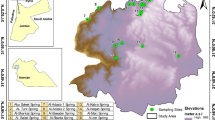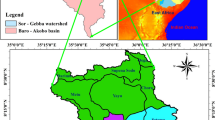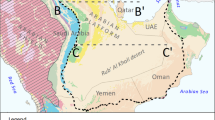Abstract
A small calcareous basin in central Spain was studied to establish the role of groundwater in the Pareja Limno-reservoir. Limno-reservoirs aim to preserve a constant water level in the riverine zone of large reservoirs to mitigate the impacts arising from their construction. Groundwater flow contribution (mean 60 %) was derived by recharge estimation. In situ measurements (spring discharge, electrical conductivity and sulfate) were undertaken and spring discharge was compared with a drought index. Twenty-eight springs were monitored and three hydrogeological units (HGUs) were defined: a carbonate plateau (HGU1), the underlying aquitard (HGU2), and the gypsum-enriched HGU3. HGU1 is the main aquifer and may play a role in the preservation of the limno-reservoir water level. Hydrogeochemical sampling was conducted and the code PHREEQC used to describe the main geochemical processes. Weathering and dissolution of calcite and gypsum seem to control the hydrogeochemical processes in the basin. Water progresses from Ca2+–HCO3 – in the upper basin to Ca2+–SO4 2– in the lower basin, where HGU3 outcrops. A clear temporal pattern was observed in the limno-reservoir, with salinity decreasing in winter and increasing in summer. This variation was wider at the river outlet, but the mixing of the river discharge with limno-reservoir water buffered it.
Résumé
Un petit bassin versant calcaire du centre de l’Espagne a été étudié afin de définir le rôle de l’eau souterraine dans le limno-réservoir de Pareja. Les limno-réservoir sont destinés à préserver un niveau constant d’eau dans la zone fluviale de grands réservoirs pour atténuer les impacts résultant de leur construction. La contribution de l’eau souterraine (60 % en moyenne) a été estimée à partir des données de recharge. Des mesures in situ (débit de sources, conductivité électrique et sulfates) ont été réalisées et l’analyse des débits des sources a été comparée avec un indice de sécheresse. Vingt-huit sources ont fait l’objet d’un suivi et trois unités hydrogéologiques (HGUs) ont été définies: un plateau carbonaté (HGU1), le substratum imperméable sous-jacent (HGU2) et un niveau enrichi en gypse HGU3. HGU1 constitue l’aquifère principal et peut jouer un rôle dans la conservation du niveau d’eau du limno-réservoir. Un échantillonnage en vue d’analyses hydrogéochimiques a été réalisé et le code PHREEQC a été utilisé pour décrire les processus géochimiques principaux. L’altération et la dissolution de la calcite et du gypse semblent contrôler les processus hydrogéochimiques du bassin versant. La chimie de l’eau évolue depuis un faciès Ca2+–HCO3 – dans la partie supérieure du bassin versant vers un faciès Ca2+–SO4 2– dans la partie inférieure, où HGU3 affleure. Une évolution temporelle claire a été observée dans le limno-réservoir, avec une salinité diminuant en hiver et augmentant en été. Cette variation est plus importante à l’embouchure de la rivière, mais le mélange entre l’eau de la rivière et l’eau du limno-réservoir l’amortit.
Resumen
Se ha estudiado una pequeña cuenca calcárea para adquirir conocimiento sobre el papel que juega el agua subterránea el Limnoembalse de Pareja. Los limnoembalses están ideados para mantener una masa de agua de nivel constante en las zonas de cola de grandes embalses y así mitigar los impactos derivados de la construcción de éstos. Se calculó la aportación subterránea (≈60 %) mediante estimación de la recarga. Se tomaron medidas in situ (caudal, conductividad eléctrica y sulfatos) y se comparó el caudal de los manantiales con un índice de sequía. Se realizó el seguimiento de 28 manantiales y se definieron tres unidades hidrogeológicas (HGUs): una plataforma carbonatada (HGU1), bajo ella, un acuitardo (HGU2), y finalmente un sustrato margo-yesífero (HGU3). La HGU1 resultó ser el principal acuífero, pudiendo jugar un papel relevante en el mantenimiento del nivel de agua del limnoembalse. También se realizó un muestreo hidrogeoquímico y los principales procesos geoquímicos fueron descritos aplicando el modelo PHREEQC. La meteorización y disolución de la calcita y el yeso parecen controlar los procesos hidrogeoquímicos en la cuenca. El agua es bicarbonatada cálcica en la cuenca alta y progresa a sulfatada cálcica en la cuenca baja, donde toma protagonismo la HGU3. Se observó un claro patrón temporal en la zona del limnoembalse, disminuyendo la salinidad en invierno y aumentando en verano. No obstante, se aprecia el efecto amortiguador ejercido por las aguas del limnoembalse con respecto a la mayor variación observada en el tramo bajo del río.
摘要
西班牙中部的一个小型石灰质流域进行了研究,确定了地下水在Pareja湖泊-水库流域的作用。湖泊-水库目的在于保持大的水库河流带恒定的水位,缓解水库建设带来的影响。据估算,平均60%的地下水流来自补给。进行了一系列现场测量(泉排泄量、电导率和硫酸盐),并把泉排泄量与干旱指数进行了对比。监测了28个泉,界定了3个水文地质单元:碳酸盐高原(单元1)、下伏的弱透水层(单元2)和富含石膏层(单元3)。单元1 是个主要含水层,可在保持湖泊-水库水位中发挥作用。进行了水文地球化学采样,采用PHREEQC编码描述了主要的地球化学过程。方解石和石膏的风化和溶解似乎控制着流域的水文地球化学过程。在单元3出露的地方,水从流域上游的Ca2+–HCO3 –型变为下游的Ca2+–SO4 2–型。在湖泊-水库中观测到了清晰的时间格局,盐度冬季降低,夏季增加。这种变化在河口更大,但河的排泄和湖泊-水库水混合减轻了这种变化。
Resumo
Uma pequena bacia calcária no centro de Espanha foi estudada para se compreender a importância das águas subterrâneas no Limno-reservatório de Pareja. Os limno-reservatórios têm como finalidade manter o nível de água constante nas zonas adjacentes de grandes reservatórios para mitigar os impactes resultantes da sua construção. A contribuição do fluxo das águas subterrâneas (média de 60 %) foi obtida por estimativas da recarga. Foram realizadas medições in situ (caudais de nascentes, condutividade elétrica e sulfatos) e os caudais das nascentes foram comparados com o índice de cheias. Foram monitorizadas vinte e oito nascentes e foram definidas três unidades hidrogeológicas (HGUs): um planalto calcário (HGU1), o aquitardo subjacente (HGU2), e a unidade rica em gesso HGU3. HGU1 é o aquífero principal e pode desempenhar um papel na preservação do nível de água do limno-reservatório. Foi também efetuada uma campanha hidrogeoquímica e o programa PHREEQC foi usado para descrever os principais processos geoquímicos. A alteração por meteorização e dissolução de calcite e de gesso parecem controlar os processos hidrogeoquímicos na bacia. A qualidade da água progride de Ca2+–HCO3 – na parte superior da bacia a Ca2+–SO4 2– na parte de jusante da bacia, onde aflora o HGU3. Foi observado um claro padrão temporal no limno-reservatório, onde a salinidade decresce no inverno e sobe no verão. Esta variação é maior na saída do rio mas a mistura do caudal fluvial com o limno-reservatório tem um efeito tampão.











Similar content being viewed by others
References
Alexakis D (2011) Assessment of water quality in the Messolonghi-Etoliko and Neochorio region (West Greece) using hydrochemical and statistical analysis methods. Environ Monit Assess 182:397–413
Álvarez Díaz MI, Galán Vergara JI (2007) Geología e Hidrogeología [Geology and hydrogeology]. In: Ayuntamiento de los Santos de la Humosa (ed) El Patrimonio Natural de Los Santos de la Humosa. Ayuntamiento de Los Santos de la Humosa, Madrid
Andre L, Franceschi M, Pouchan P, Atteia O (2005) Using geochemical data and modeling to enhance the understanding of groundwater flow in a regional deep aquifer, Aquitain Basin, south-west of France. J Hydrol 305:40–62
Cabra Gil P (1998) Geomorfología [Geomorphology]. In: Mapa geológico de España Escala 1:50000-Auñón [1:50000 Geological map of Spain-Auñón]. Instituto Tecnológico Geominero de España, Madrid
Cherry JA, Parker BL, Bradbury KR, Eaton TT, Gotkowitz MG, Hart DJ, Borchardt MA (2004) Role of aquitards in the protection of aquifers from contamination: a “state of the science” report. Awwa Research Foundation, Denver, CO
Confederación Hidrográfica del Tajo (2007) Estudio general sobre la Demarcación Hidrográfica [General study of the Hydrographic Confederation]. Ministerio de Medio Ambiente, Madrid
Custodio E, Llamas MR (1983) Hidrología subterránea, tomo I [Groundwater hydrology, vol I]. Ediciones Omega, Barcelona
del Pozo J (1998) Hidrogeología [Hydrogeology]. In: Mapa Geológico de España Escala 1:50000-Auñón [1:50000 Geological map of Spain-Auñón]. Instituto Tecnológico Geominero de España, Madrid
Dussaubat S, Vargas X (2005) Aforo en un cauce natural [Water flow gauging in a natural watercourse]. Dept. de Ingeniería Civil, Universidad de Chile, Santiago
European Environment Agency (EEA) (2012) European waters: assessment of status and pressures. EEA report no. 8/2012. European Environment Agency, Copenhagen
Fiorillo F, Doglioni A (2010) The relation between karst spring discharge and rainfall by cross-correlation analysis (Campania, southern Italy). Hydrogeol J 18:1881–1895
Fiorillo F, Gaudagno FM (2010) Karst spring discharges analysis in relation to drought periods, using the SPI. Water Resour Manag 24:1867–1884
Freeze RA, Cherry JA (1979) Groundwater. Prentice Hall, Englewood Cliffs, NJ
García de la Torre J (1976) Estudio hidrogeológico de la cuenca baja del río Tajuña [Hydrogeological study of the Tajuña River lower basin]. BSc Thesis, Universidad Complutense, Madrid
Gómez R, García V, Vidal-Abarca MR, Suárez ML (2009) Effect of intermittency on N spatial variability in an arid Mediterranean stream. J N Am Benthol Soc 28(3):572–583
Helfferich F (1962) Ion exchange. McGraw-Hill, New York
Hernaiz Huerta PP, Cabra Gil P, Solé Pont J, Portero J, del Olmo P (1998) Mapa geológico de España escala 1:50000-Auñón [1:50000 Geological map of Spain-Auñón]. Instituto Tecnológico Geominero de España, Madrid
IGME (2013) Unidades Hidrogeológicas de España [Hydrogeological units of Spain]. Available at: http://aguas.igme.es/igme/princi.htm. Accessed 21 March 2013
Intergovernmental Panel on Climate Change (2007) Climate Change 2007: Synthesis Report. Contribution of Working Groups I, II and III to the Fourth Assessment Report of the Intergovernmental Panel on Climate Change [Core Writing Team, Pachauri RK, Reisinger A]. IPCC, Geneva
Jin L, Siegel DI, Lautz LK, Mitchell MJ, Dahms DE, Mayer B (2010) Calcite precipitation driven by the common ion effect during groundwater–surface-water mixing: a potentially common process in streams with geologic settings containing gypsum. Geol Soc Am Bull 122(7-8):1027–1038
Krishna Kumar S, Chandrasekar N, Seralathan P, Godson PS, Magesh NS (2012) Hydrogeochemical study of shallow carbonate aquifers, Rameswaram Island, India. Environ Monit Assess 184:4127–4138
La Moneda González E (1989) Hidrogeología [Hydrogeology]. In: Mapa geológico de España escala 1:50000-Valdeolivas [1:50000 Geological map of Spain-Valdeolivas]. Instituto Tecnológico Geominero de España, Madrid
Lambán LJ, Heredia J, Valverde M (eds) (2009) El papel del agua subterránea en el funcionamiento de los humedales [The role of groundwater in wetlands functioning]. AIH-GE, Zaragoza, Spain
Langmuir D (1997) Aqueous environmental geochemistry. Prentice Hall, Englewood Cliffs, NJ
Lloyd-Hughes B, Saunders MA (2002) A drought climatology for Europe. Int J Climatol 22:1571–1592
López Olmedo F, Montes M, Nozal F, Díaz de Neira A, Luengo J, Martín Baranda R (2008) El paleógeno de la provincia de Guadalajara: el comienzo de una nueva era—la formación de las cordilleras y cuencas continentales [Paleogene in the province of Guadalajara: the beginning of a new era—the origin of mountain ranges and continental basins]. In: Calonge A, Rodríguez M (eds) Geología de Guadalajara. Obras Colectivas Ciencias 03. Universidad de Alcalá de Henares, Alcalá de Henares, Madrid
López-Geta JA, Fornés Azcoiti JM (eds) (2009) La geología e hidrogeología en la investigación de humedales [Geology and hydrogeology in wetlands research]. IGME, Madrid
López-Vera F (2012) Groundwater: the invisible resource. Int J Water Resour Dev 28(1):141–150
Lovelli S, Perniola M, Di Tommaso T, Ventrella D, Moriondo M, Amato M (2010) Effects of rising atmospheric CO2 on crop evapotranspiration in a Mediterranean area. Agr Water Manag 97(9):1287–1292
Maestro Salmerón MT, Llamas Madurga MR, Rublio Martín PL (1986) Contribución al conocimiento hidrogeoquímico de las calizas de los páramos [Contribution to the hydrogeochemical knowledge of the plateau limestones]. In: Jornadas sobre la explotación de aguas subterráneas en la Comunidad de Madrid. CAM, Canal de Isabel II, Madrid
Martín Loeches M, Rebollo L (2008) Hidrogeología de la provincia de Guadalajara [Hydrogeology of the Guadalajara province]. In: Calonge A, Rodríguez M (eds) Geología de Guadalajara. Obras Colectivas Ciencias 03. Universidad de Alcalá de Henares, Alcalá de Henares, Madrid
McKee TB, Doesken NJ, Kleist J (1993) The relationship of drought frequency and duration to time scales. In: Eighth Conference on Applied Climatology, Anaheim, CA, January 1993, American Meteorological Society, Boston
Ministerio de Medio Ambiente, Comité Nacional Español de Grandes Presas (CNEGP) (1996) Embalses y medio ambiente [Reservoirs and environment]. Centro de Publicaciones del Ministerio de Medio Ambiente, Madrid
Ministerio de Medio Ambiente (2007) La sequía en España: directrices para minimizar su impacto [Drought in Spain: guidelines to minimize its impact]. Comité de Expertos en Sequía, Ministerio de Medio Ambiente, Madrid
Molina-Navarro E, Martínez Pérez S, Sastre Merlín A (2010) El limnoembalse de Cola de Pareja (Guadalajara): Aspectos medioambientales e hidrológicos [The Pareja Limno-reservoir (Guadalajara): environmental and hydrological aspects]. Bol Geol Min 121:69–80
Molina-Navarro E, Martínez Pérez S, Sastre Merlín A, Bienes-Allas R (2014) Hydrologic modeling in a small Mediterranean Basin as a tool to assess the feasibility of a limno-reservoir. J Environ Qual 43(1):121–131
Moreno Merino L, de la Losa Román A (2008) INAQUAS: utilidad para la Interpretación de Análisis Químicos de Aguas Subterráneas [INAQUAS: a tool for interpretation of hydrogeochemical analyses]. IGME, Madrid
National Drought Mitigation Center (NDMC) (2013) Program to calculate standardized precipitation index. University of Nebraska, Lincoln, NB. Available at: http://drought.unl.edu/MonitoringTools/DownloadableSPIProgram.aspx. Accessed 26 Feb 2013
Parkhurst DL, Appelo CAJ (2013) Description of input and examples for PHREEQC version 3: a computer program for speciation, batch-reaction, one-dimensional transport, and inverse geochemical calculations. US Geological Survey, Denver, CO
Piper AM (1944) A graphical procedure in the geochemical interpretation of water analysis. Am Geophys Union Trans 25:914–928
Remeneiras G (1974) Tratado de hidrología aplicada [Treatise on applied hydrology]. Editores Técnicos, Barcelona
Sánchez-Montoya MM, Arce MI, Vidal-Abarca MR, Suárez ML, Prat N, Gómez R (2012) Establishing physico-chemical reference conditions in Mediterranean streams according to the European Water Framework Directive. Water Res 47(7):2257–2269
Sastre Merlín A, Martínez Pérez S, Jurado Gamo A, Acaso Deltell E (2008) Geohidrología del humedal de El Hito (prov. de Cuenca) [Hydrogeology of El Hito wetland (province of Cuenca)]. In: IX Simposio de Hidrogeología. AEH, Elche, Spain
Schneider C, Laizé CLR, Acreman MC, Flörke M (2013) How will climate change modify river flow regimes in Europe? Hydrol Earth Syst Sci 17:325–339
Shanmugam P, Ambujam NK (2012) A hydrochemical and geological investigation on the Mambakkam mini watershed, Kancheepuram District, Tamil Nadu. Environ Monit Assess 184:3293–3306
Stiff HA Jr (1951) The interpretation of chemical water analysis by means of patterns. J Petrol Technol 3(10):15–17
Villarroya FI, Rebollo LF (1978) Funcionamiento hidrogeológico del karst de la Alcarria: la mesa de Chinchón-Villarejo de Salvanés (Madrid) [Hydrogeological functioning of karst in La Alcarria: the Chinchón-Villarejo de Salvanés mesa (Madrid)]. Estud geol 34:231–240
Acknowledgements
Funding for this research came from the Social Action of Ibercaja and the Government of Castilla-La Mancha (Science and Education Department, research project PAI08-0226-1758). Eugenio Molina-Navarro received additional support from a predoctoral grant from the University of Alcalá. The authors thank the Pareja City Council and the Confederación Hidrográfica del Tajo for their support. Special thanks go to Andrew Sadler for his valuable English language comments, to Dr. M. Martín-Loeches and Dr. Luis Rebollo for providing bibliographic references and to the study area citizens that helped in the location of springs, especially to Salvador Ortiz.
Author information
Authors and Affiliations
Corresponding author
Electronic supplementary material
Below is the link to the electronic supplementary material.
ESM 1
(PDF 306 kb)
Rights and permissions
About this article
Cite this article
Molina-Navarro, E., Sastre-Merlín, A., Vicente, R. et al. Hydrogeology and hydrogeochemistry at a site of strategic importance: the Pareja Limno-reservoir drainage basin (Guadalajara, central Spain). Hydrogeol J 22, 1115–1129 (2014). https://doi.org/10.1007/s10040-014-1113-5
Received:
Accepted:
Published:
Issue Date:
DOI: https://doi.org/10.1007/s10040-014-1113-5




